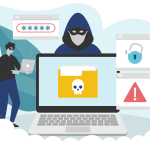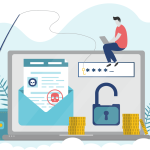Don’t Be Fooled: How to Spot a Cyber Breach
June 18, 2024

In today’s digital age, businesses heavily rely on technology for their day-to-day operations, making the threat of cyber breaches more significant than ever. From small startups to multinational corporations, no one is safe from the potential devastation caused by a cybersecurity breach. But fear not, business owners armed with the right knowledge and tools can stay one step ahead of cyber breaches.

Picture this: you’re working diligently on an important project when suddenly, your computer freezes. Panic sets in as you realize you haven’t saved your progress in hours. Is it just a simple computer crash, or could it be something more sinister lurking beneath the surface?
According to IBM’s Cost of a Data Breach Report, the global average data breach cost in 2023 was a staggering $4.45M USD. Closer to home, in 2023, 40% of Canadian organizations experienced an employee and/or customer data breach last year (an 11% increase from 2022). In addition, three-quarters of Canadians are concerned about malware and about one-fifth (19%) have been a victim of a successful cyberattack.
These statistics serve as a stark reminder of the importance of staying vigilant against cyber threats. To protect yourself and your organization, it’s crucial to know how to effectively spot a breach. Here are some key indicators to watch for:
Disclaimer: Please note that the information provided herein offers guidelines only. It is not exhaustive and does not constitute legal, insurance, or cybersecurity advice. For more guidance, please consult a lawyer, a licensed insurance representative, and/or a cybersecurity specialist.
How do you spot a breach?
1. Missing or Altered Files
If files suddenly go missing or appear to have been tampered with, it could be a sign of a breach. Examples of tampering include changes in file names, unauthorized changes to file content, or files appearing in unexpected locations. Pay close attention to sensitive or critical files, as these are often targets for cybercriminals.
2. New or Strange Files
Similarly, be vigilant about new files appearing on your system unexpectedly or with unusual names. These could be indicators of malware trying to infiltrate your system. Regularly scan for suspicious files and report and remove any threats.
3. Unexplained Network Activity
Watch for unusual spikes or drops in your network’s activity. This could mean someone is accessing your systems without permission. Look for strange data transfers, unknown devices connected to your network, or any unusual patterns.
4. Strange Pop-ups or Redirects
Be wary of unexpected pop-up ads or browser redirects, as these could be attempts to infiltrate your system. These can lead to malicious websites designed to steal your information or install malware.
5. Unexplained Password Changes
If you or your employees notice that their passwords have been changed without authorization, it’s time to investigate. Unauthorized password changes can indicate that a cybercriminal has gained access to your accounts.
6. Suspicious Emails or Phishing Attempts
Phishing is a common method used by cybercriminals to gain access to your systems via email or websites. Staff should know how to recognize the signs of phishing emails, such as misspelled URLs, unexpected attachments, or requests for sensitive information. Suspicious emails should be reported and deleted to prevent potential breaches.
7. Unauthorized Devices
Be on the lookout for unfamiliar devices that connect to your network. Unknown devices can be used to gain access to your systems and data. Regularly monitor connected devices and restrict network access to approved devices only.
8. Disabled Security Software or Unauthorized Security Changes
Regularly check that your security software is running properly. If you notice that antivirus programs, firewalls, or other security measures have been disabled or altered without authorization, it could be a sign of a cyberattack, designed to avoid detection.
RELATED: Wait, what’s a privacy breach again?
PRO Tips: How can you stay secure?
1. Bolster your security.
Strengthen your security to make sure you’re in the best position possible to ward off a breach. Use multi-factor authentication (MFA) where critical or sensitive data is stored or transmitted. Install firewalls, anti-virus software, and VPNs on devices to protect your network. Encrypt sensitive data during transmission and storage. Consult with cybersecurity experts to find the best measures for your business.
2. Keep software updated.
Regularly updating your operating systems and software is crucial for maintaining security. Without updating, your systems are at risk of being compromised by malware or unauthorized access. By keeping your software current, you close security gaps and protect your business from potential breaches.
3. Back-up your data.
Implement a data backup strategy to ensure that your critical files are protected in the event of a breach. Regularly backing up data can help you recover quickly from cyber incidents like ransomware attacks. Having secure backups means you can restore your systems with minimal downtime and data loss, maintaining business continuity.
For maximum protection, we recommend implementing a separate, offline backup system to prevent hackers from accessing network backups and increase the chances of data recovery. Learn more here.
4. Train your employees.
Providing cybersecurity training helps employees understand their role in protecting the company, since many might not even realize what counts as a breach or how to handle data securely. Emphasize phishing awareness, as it is a leading cause of data compromise. Teach staff to identify suspicious emails, such as those with misspelled URLs or unexpected requests for sensitive information. With proper training, your team becomes the first line of defence against cyber threats.
RELATED: Security Awareness Training: What is it, Best Practices, & More
5. Consider Cyber Insurance.
No matter how much you prepare, it’s impossible to prevent all cyber breaches. Cyber Insurance can help your company recover from an attack by covering costs associated with data breaches. You can ensure that your business is better equipped to handle the financial and operational impacts of a cyber breach, providing peace of mind and financial security.
Coverage highlights include:
- Legal fees, damages, and defence costs;
- A specialized data forensics team to investigate the cause of the breach;
- A legal breach coach to advise you on response and regulatory compliance;
- Client notification and credit monitoring for affected parties;
- PR consulting services to manage reputational harm;
- And more!
RELATED: All About Cyber Insurance: What is it, What’s Covered, and Why Do You Need it?
6. Work with a broker.
Partnering with a reputable broker like PROLINK can provide you with the peace of mind knowing that you’re covered in the event of a cyber breach. With over 40 years of experience and specialized knowledge of cyber markets, PROLINK is ahead of industry trends. Our dedicated team of risk advisors will:
- Identify exposures based on your business operations and unique needs;
- Share what steps others in your industry are taking and advise you accordingly;
- Outline a proactive approach to risk management to control your costs long-term;
- Conduct a robust assessment of your existing insurance policies to detect any coverage gaps;
- Secure a specialized solution that aligns with your strategic objectives.
RELATED: Prepare Now or Pay Later: How Can Businesses Mitigate the Risk of Ransomware?
Spotting a cyber breach before it strikes requires a combination of vigilance, education, and proactive security measures. By staying informed, investing in cybersecurity, and working with trusted partners, you can safeguard your business against the ever-evolving threat of cybercrime.
Remember, when it comes to cybersecurity, it’s always better to be safe than sorry. To learn about your exposures and how you can protect yourself, visit our Cyber Security & Privacy Breach Toolkit and connect with PROLINK today for more guidance!
PROLINK’s blog posts are general in nature. They do not take into account your personal objectives or financial situation and are not a substitute for professional advice. The specific terms of your policy will always apply. We bear no responsibility for the accuracy, legality, or timeliness of any external content.




